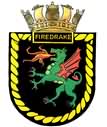 HMS Firedrake's Captain Stephen Norris DSO. DSC. RN |
| HMS Firedrake’s long serving Commanding Officer Lieutenant Commander Stephen Norris DSO DSC RN. As his rank was then, when in charge of the Firedrake, had served in her from April 1938 until April 1942, he was in charge when Firedrake and two other destroyers sank the first U-boat of world war II, the U39, of which he was awarded the DSC, he commanded the Firedrake through the second battle of Narvik, and convoy escort duties through to America, Canada, Iceland, Norway, Gibraltar and Malta, and the battle Spartivento and the bombardment of Genoa, against the Italians with force H, he was awarded the DSO for the sinking of the Italian submarine Durbo, he was magnificent in getting the Firedrake back to Gibraltar, after being damaged by an Italian 500kilo bomb, that had blasted a massive hole in her starboard-side, when escorting a convoy to Malta with Force H in July 1941. Photo right Lieut. Cdr S. H. Norris, R.N., D.S.O., D.S.C. |
|
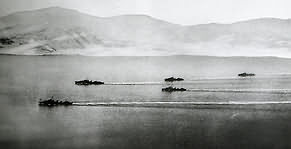 Photo above: The "F" Class steaming up Ofotfjord in the Second Battle of Narvik. 13th April 1940 |
When
the engineering officer was wrestling to start the engines again,
after they had been knocked out by the blast, Stephen Norris stayed
on the bridge keeping watch for enemy aircraft. On one occasion the steward, George Walker was summoned to take a mug of tea and sandwiches to him, when George got there Norris was sitting in his chair with his feet up on the mantle singing chick, chick, chick, chick, chicken lay a little egg for me, this bought a beaming smile to George’s face and made him feel at ease, it was several hours before the engines were going again, and then they couldn’t reach full power, so it was a long 900 mile voyage back to Gibraltar. |
| They were attacked again, once when they were at a stand still, the pilot of the Italian aircraft must have thought that Firedrake was finished, because he didn’t drop his bombs, the second time the bombs missed. On the way back to Gibraltar, the rest of force H came by after delivering their convoy to Malta, as the ships raced by all the ships crews cheered the Firedrake. |
| When
the Firedrake was being attacked by stuka's in Narvik, it was said
that Commander Norris, used to lay on his back on the bridge, and
wait for the stuka's to let the bombs go, then he would direct the
ship, this was very successful, as Firedrake was attacked many times
but manage to dodge every bomb, she did however have some very close
near misses, and sustained a bit of shrapnel damage but nothing
serious, and got through that campaign successfully. Photo Right:The Second Battle of Narvik. |
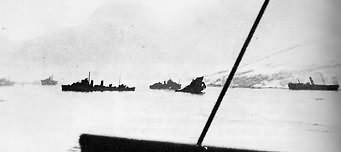 |
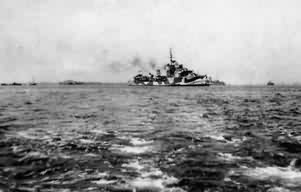 |
Commander
Norris was well liked by his officers and crew, and through out
the flotilla, he was sometimes referred to affectionately as Nudger
Norris, after his encounter with one of the oilers in Scapa Flow. After four years of war with the Firedrake, the ships doctor at the time Dr John Aldren, convinced Stephen Norris who was now 39 years of age, to take a less demanding shore job, that had come begging. Photo Left: Firedrake with her new paint job in the Mediterranean after her refit at Chatham in July 1941 at the start of operation "Substance" |
| So in April 1942 he handed the Firedrake over to Commander Banks, who however only remained a few months. In September 1942 the Firedrake came under the command of Commander E.H.Tilden DSO RN. He had been running the anti-submarine training establishment HMS Osprey since June 1941, so a number of the men on the Firedrake already knew him. Three months later on the night of 16/17th December 1942, the Firedrake was lost with 168 of her crew. Commander Tilden did not survive. |
| What
happened to Lt Comm. Norris after leaving the Firedrake is now a
bit patchy, according to the Gazette, he was made a full commander
in June 1943. He was mentioned in dispatches for bravery in the
allied landings in north Africa (Operation Torch) in 1942. He was
awarded a bar to his DSC for gallantry in the operation to capture
Sicily, and a bar to his DSO for gallantry during the invasion of
the South of France. He was made an acting Captain in 1943 and a
full Captain in 1944. Photo right: The 51st Highland Division coming ashore on Sicily on the 9th July 1943, where Captain Stephen Norris was awarded a bar to his DSC for gallantry during the invasion and capture of the island. |
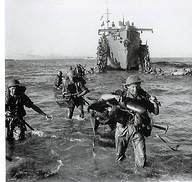 |
| But then on the 13th November 1944 at the age of 41, Captain Stephen Norris DSO DSC RN was killed on active service and is buried in a Belgrade war cemetery number 96. |
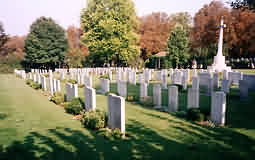 |
The
cemetery is in Uliga Baju Sekulica, in the city’s fifth region,
and is on the edge of the New Yugoslav Cemetery (Novo Groblije).
The cemetery was created to receive, the remains of British and
commonwealth casualties, brought in from more than sixty small burial
grounds, and from isolated sites all over Yugoslavia. The largest number from any one place came from Milna Military Cemetery and the Royal Naval Harbour Cemeteries on the island of Vis (Lissa) which was our base. The burials in the War Cemetery include escaped prisoners of war from Italy and Greece. |
| The
civilians buried here include a mining technician, a teacher of
English, a newspaper correspondent, a number of the Embassy staff
and the child of another member of Embassy staff. They were buried or reburied in the cemetery by permission of the Army Graves Service. |
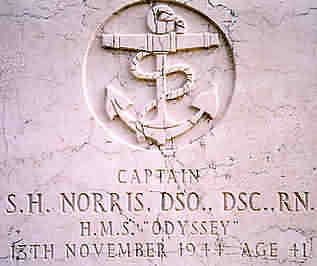 |
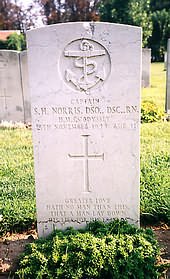 |
|
So there’s still unanswered questions of what happened to Capt. Stephen Norris DSO DSC RN. Where exactly was he killed, and what was he doing there. I hope my research will reveal all one day. |
|
R.I.P.
Capt. S. H. Norris DSO, DSC, RN.
|
|
|
 HMS Firedrake's Last Commanding Officer Commander E.H.Tilden DSC RN |
|
Comm. EH Tilden DSC RN |
Commander E.H.Tilden DSC RN was the last C.O. of HMS Firedrake he was lost with the ship on the night of 16/17th December 1942. The information on this page has been supplied by his two surviving sons Jim and Bill Tilden. Eric
Henry (Tom) Tilden was born in Epsom Surrey in May 1905 to Harry
and Ada Tilden, the third of five children. Harry came from several
generations of bankers and worked for the Bank of England. Ada
Osmond came from a farming family in Totteridge. |
| Eric Henry (Tom) Tilden went to Rosehill Preparatory school in Surrey from where he went on to the Naval College at Osborne and then to Dartmouth. No previous Tilden had gone into the Navy, but the family kept a wherry (a small half-decked sailing boat) on the Norfolk broads, so perhaps this stimulated his desire to follow a naval career. Tom was a good sportsman in that he boxed and fenced for the Navy. |
| Tom met his wife Susan Jones who became a professional cellist, when they were only 13. They married in 1930 with a full Naval ceremonial wedding in Holy Trinity Church, Cookham, Berkshire, where the Jones had a riverside weekend house. They lived initially in Weymouth where their first child Judith was born in 1934, followed by Jim in 1937, Cordelia 1939, and Bill in 1942. Tom's family don’t have records of his naval career, but the Times obituary published shortly after the loss of HMS Firedrake gives an accurate account and is reproduced below, together with some additional information. |
|
From
the Obituary in the Times of the 24th December 1942
|
| Commander Eric Henry Tilden D.S.C RN,Who was reported missing, presumed killed, was an antisubmarine specialist and had qualified at the Royal Naval Staff College. He entered Osborne as a naval cadet in January 1919, left Dartmouth in July 1922 and after completing his sea training in the cruiser HMS Thunderer he became a midshipman from May 1923. He served on HMS Barham in home waters and in the Mediterranean. |
| He was promoted to Sub-Lieutenant in 1926 and Lieutenant in 1928, he served in the destroyer HMS Wryneck and the Battleship HMS Ramillies in the Mediterranean before specializing in anti-submarine duties in 1931. In 1936 he was A/S officer for the 6th destroyer flotilla in China. He also served for two years on the staff of the anti-submarine school HMS Osprey at Portland. On completing the course at the RN staff college, Greenwich, in December 1938, he was promoted to Lieutenant Commander and joined HMS Nelson, |
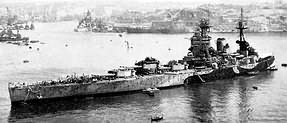 HMS Nelson |
| the Home Fleet Flagship. In June 1940 he was awarded the D.S.C. for services in her operations on the Norwegian Coast. He was promoted to Commander in June 1941, when he took command of HMS Osprey which had been moved to Dunoon in Scotland because of the danger of bombing. He remained at Dunoon until September 1942 when he took command of the destroyer HMS Firedrake, from Commander Banks, who himself had only taken over from commander Steven Norris DSO DSC RN earlier the same year. |
|
R.I.P.
HMS Firedrake's Last Commanding Officer Commander E.H.Tilden DSC
RN
|
|
|
 |
|
Captain
William Eric Banks
Commanding Officer HMS Firedrake May 1942 - September 1942 |
| William
Eric Banks Joined the Royal Navy in 1918, he retied in 1952 and
sadly crossed the bar on 1st November 1986. A midshipman: 25 April 1920, he finished as Captain in 1952. He Joined HMS Dolphin 29 July 1923, for training in submarines and on completion moved to HMS Conquest for service in HMS/m M-3 a minelaying boat. Five months later, he transferred to HMS/m L25 working from Dolphin and a year later, still at Dolphin, transferred to H48 used for training purposes as a First-Officer. He spent two years in General Service aboard the battle cruiser HMS Tiger, before returning to Dolphin in January 1928 to work on HMS/m Oberon in the 5th Submarine Flotilla. |
|
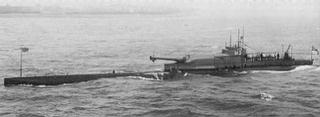 Photo above the M-3 |
In
April 1930, he returned again to General Service aboard HMS Berwick
and two years later, found himself once again at Dolphin for his
COQC. In June 1933, he took command of HMS/m L18 and a little over a year later, in July 1934, was moved to HMS Medway (4th Submarine Flotilla) in China. He remained there as Commanding Officer of HMS/m Perseus. |
| After
three years he went to the Maidstone (1st Submarine Flotilla) in
the Mediterranean working as Commanding Officer HMS/m Clyde. When
war broke out, he was moved to HMS Seaborne II and while there,
became Commanding Officer of the French ship, Leopard. It was during
this period that on the 26.07.1940 he won his DSC for preventing
the capture of war materials. On 4th May 1942 he joined HMS Firedrake as Captain and received a Mention in Dispatches for duties with her. In November 1942 he took command of HMS Bonaventure, tender to the midget submarines. Then in April 1943, he took command of HMS Varbel the shore establishment for the experimental midget submarines and was involved in ‘Operation Source’ the attack on the German battleship Tirpitz in Norwegian waters on the 22nd September 1943, for this he received the CBE. In December 1944 till July 1945 he was Captain Landing Craft Mediterranean at HMS Byrsa. In January 1946 he became the Commanding Officer of the cruiser HMNZS Achilles. After the war, he moved to HMS Osprey in charge of training in the anti-submarine establishment at Devonport. He went from there to HMS Highflyer in Ceylon as naval advisor to the Government. He retired from the navy, after a distinguished career, in 1952. |
| Cpt
Banks, "Willie" to his officers and "Monty"
to the crew. A Midshipman: 25 April 1920. Sub-Lieutenant: 15 May 1921. Lieutenant: 15 April 1923. Lieutenant-Commander: 15 April 1931. Commander: 30 June 1937. Captain: 31 December 1942. DSC awarded: 27 July 1940. CBE awarded: 21 December 1943. Mentioned in Dispatches: 1943, while C.O. HMS Firedrake. Photo right: one of the X-craft that took part in the attack on the German Battleship Tirpitz. |
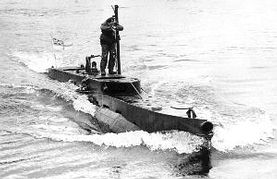 |
|
Grateful
thanks to George Malcolmson and Debbie Corner of the Submarine
Museum, and Hans Houterman for supplying the information for this
article.
|
|
Captain
W. E. Banks RN DSC CBE. Died 1st November 1986. R.I.P.
|
|
|
 |
|
Commander
John Malcolm Rodgers DSC
HMS Firedrake 1937 |
|
Off duty above. Lieut.-Commander J. M. Rodgers of the destroyer Firedrake rehearsing a comedy number for a warship concert in aid of the victims of submarine M2. |
In
April 1937, John Malcolm Rodgers was the Lieut. Commander in charge
of the Firedrake on station in the Mediterranean. In April 1937 Spain was embroiled in a civil war, so the Battlecruiser Hood and Destroyer Firedrake were sent to escort three tramp steamers S.S. Hamsterley, SS MacGregor and SS Stanbrook, from the little French port of St. Jean de Luz, with a cargo of food stuffs through the blockade to the port of Bilbao. The convoy came under fire from the Spanish warship Almirante Cervera and the armed trawler Galerna, the Firedrake took up station between the Spanish and the convoy and eventually chased the armed trawler away after it had come under fire from shore batteries. After about three hours of very tense manoeuvres, tactics and flag waving between the Hood and the Almirante Cervera the three merchant ships steamed into Bilbao harbour to a welcome of cheers from the crowds that had formed on the quay to welcome them, even though there was an air raid on at the time. |
| The
event was reported in the Daily Express the next day by Stephen
Charing who was aboard the Hamsterley. Daily Express artists impression of the encounter between the blockade running food ships, Franco’s crack warship and an armed trawler. White dotted lines indicate shells one fired from the Almirante Cervera and falling between the MacGregor and the Hamsterley, the other fired by the trawler across the bows of the Hamsterley. |
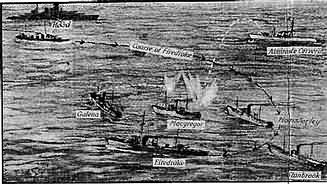 |
| Below two of the warships involved in the incident left is the British Battlecruiser HMS Hood. On the right is the Spanish Battlecruiser Almirante Cervera. Bottom right HMS Whirlwind one of the destroyers that Commander J. M. Rodgers served on after the Firedrake. |
 HMS Hood |
 Almirante Cervera |
| More
information about Commander J. M. Rodgers DSC. Lt. Cdr 1930, A/Cdr 1940, Cdr 1950 and retied 1952. Honours: Distinguished Service Cross 08.06.1944. HMs Birthday 1944. Mentioned in Dispatch 23.12.1939. Successful action against enemy submarine. Mentioned in Dispatch 26.09.1940. Norway 04.06.1940. Ships after the Firedrake:- 1938. HMS Hermes, aircraft carrier. 1939. HMS Whirlwind, destroyer. 1942. HMS Watchman, destroyer, Commanding Officer. 1943. HMS Vesper, destroyer, Commanding Officer. 1944. HMS Merlin, Shore base naval air station. |
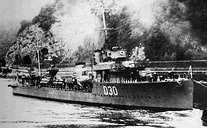 HMS Whirlwind |
|
|
|
Other
Pages Below
|